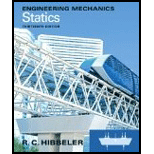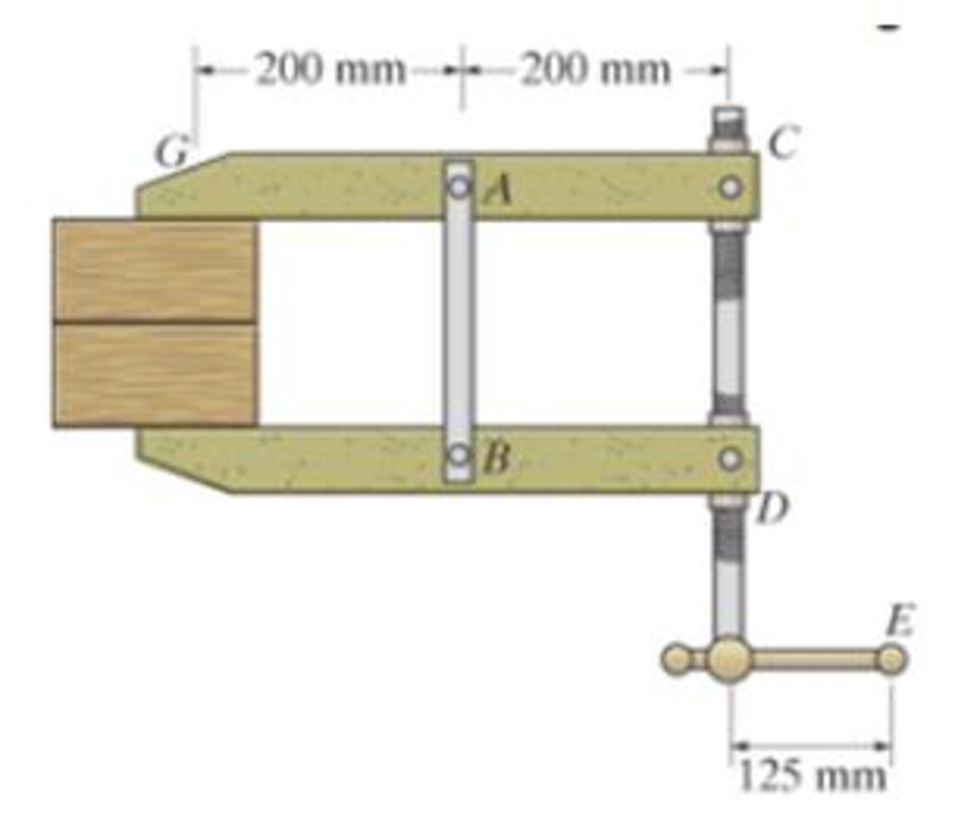
Engineering Mechanics: Statics and Study Pack (13th Edition)
13th Edition
ISBN: 9780133027990
Author: Russell C. Hibbeler
Publisher: Prentice Hall
expand_more
expand_more
format_list_bulleted
Concept explainers
Textbook Question
Chapter 8.4, Problem 71P
If the clamping force at G is 900 N, determine the horizontal force F that must be applied perpendicular to the handle of the lever at E. The mean diameter and lead of both single square-threaded screws at C are D are 25 mm and 5 mm, respectively. The coefficient of static friction is, μs = 0.3.

Expert Solution & Answer
Want to see the full answer?
Check out a sample textbook solution
Students have asked these similar questions
This is an old practice exam. Fce = 110lb and FBCD = 62 lb but why
Quiz/An eccentrically loaded bracket is welded to the support as shown in Figure below. The load is static. The weld size
for weld w1 is h1 = 4mm, for w2 h2 = 6mm, and for w3 is h3 =6.5 mm. Determine the safety factor (S.f) for the welds.
F=29 kN. Use an AWS Electrode type (E100xx).
163 mm
S
133 mm
140 mm
Please solve the question above
I solved the question but I'm sure the answer is wrong
the link :
https://drive.google.com/file/d/1w5UD2EPDiaKSx3W33aj
Rv0olChuXtrQx/view?usp=sharing
Q2: (15 Marks)
A water-LiBr vapor absorption system incorporates a heat exchanger as shown in
the figure. The temperatures of the evaporator, the absorber, the condenser, and the
generator are 10°C, 25°C, 40°C, and 100°C respectively. The strong liquid leaving
the pump is heated to 50°C in the heat exchanger. The refrigerant flow rate through
the condenser is 0.12 kg/s. Calculate (i) the heat rejected in the absorber, and (ii) the
COP of the cycle.
Yo 8
XE-V
lo
9
Pc
7
condenser
5
Qgen
PG
100
Qabs
Pe
evaporator
PRV
6
PA
10
3
generator
heat exchanger
2
pump
185
absorber
Chapter 8 Solutions
Engineering Mechanics: Statics and Study Pack (13th Edition)
Ch. 8.2 - Determine the friction developed between the 50-kg...Ch. 8.2 - Determine the minimum force P to prevent the 30-kg...Ch. 8.2 - Determine the maximum force P that can be applied...Ch. 8.2 - If the coefficient of static friction at contact...Ch. 8.2 - Determine the maximum force P that can be applied...Ch. 8.2 - Prob. 6FPCh. 8.2 - Blocks A, B, and C have weights of 50 N, 25 N, and...Ch. 8.2 - If the coefficient of static friction at all...Ch. 8.2 - Using the coefficients of static friction...Ch. 8.2 - Prob. 1P
Ch. 8.2 - The tractor exerts a towing force T=400 lb....Ch. 8.2 - The winch on the truck is used to hoist the...Ch. 8.2 - Prob. 4PCh. 8.2 - Prob. 5PCh. 8.2 - Prob. 6PCh. 8.2 - The block brake consists of a pin-connected lever...Ch. 8.2 - The block brake consists of a pin-connected lever...Ch. 8.2 - Prob. 9PCh. 8.2 - Prob. 10PCh. 8.2 - The block brake is used to stop the wheel from...Ch. 8.2 - If a torque of M=300 Nm is applied to the...Ch. 8.2 - The cam is subjected to a couple moment of 5N m....Ch. 8.2 - Determine the maximum weight W the man can lift...Ch. 8.2 - The car has a mass of 1.6 Mg and center of mass at...Ch. 8.2 - Prob. 16PCh. 8.2 - Prob. 17PCh. 8.2 - Prob. 18PCh. 8.2 - Prob. 19PCh. 8.2 - Prob. 20PCh. 8.2 - Prob. 21PCh. 8.2 - Prob. 22PCh. 8.2 - A 35-kg disk rests on an inclined surface for...Ch. 8.2 - The man has a weight of 200 lb, and the...Ch. 8.2 - Prob. 25PCh. 8.2 - Prob. 26PCh. 8.2 - Prob. 27PCh. 8.2 - Prob. 28PCh. 8.2 - Prob. 29PCh. 8.2 - Prob. 30PCh. 8.2 - If the coefficient of static friction at A and B...Ch. 8.2 - Prob. 32PCh. 8.2 - Prob. 33PCh. 8.2 - Prob. 34PCh. 8.2 - Prob. 35PCh. 8.2 - Prob. 36PCh. 8.2 - Prob. 37PCh. 8.2 - Prob. 38PCh. 8.2 - Prob. 39PCh. 8.2 - Two blocks A and B have a weight of 10 Ib and 6...Ch. 8.2 - Two blocks A and B have a weight of 10 Ib and 6...Ch. 8.2 - Prob. 42PCh. 8.2 - Prob. 43PCh. 8.2 - Prob. 44PCh. 8.2 - Prob. 45PCh. 8.2 - The beam AB has a negligible mass and thickness...Ch. 8.2 - It is supported at one end by a pin and at the...Ch. 8.2 - Prob. 48PCh. 8.2 - Prob. 49PCh. 8.2 - Prob. 50PCh. 8.2 - Prob. 51PCh. 8.2 - Prob. 52PCh. 8.2 - The wheel weights 20 lb and rests on a surface for...Ch. 8.2 - Prob. 54PCh. 8.2 - Determine the greatest angle so that the ladder...Ch. 8.2 - Prob. 56PCh. 8.2 - Prob. 57PCh. 8.2 - Prob. 4CPCh. 8.4 - Determine the largest angle that will cause the...Ch. 8.4 - If the beam AD is loaded as shown, determine the...Ch. 8.4 - Prob. 60PCh. 8.4 - Prob. 61PCh. 8.4 - If P=250 N, determine the required minimum...Ch. 8.4 - Determine the minimum applied force P required to...Ch. 8.4 - Prob. 64PCh. 8.4 - Prob. 65PCh. 8.4 - Prob. 66PCh. 8.4 - Prob. 67PCh. 8.4 - If the clamping force on the boards is 600 lb,...Ch. 8.4 - Prob. 69PCh. 8.4 - If the force F is removed from the handle of the...Ch. 8.4 - If the clamping force at G is 900 N, determine the...Ch. 8.4 - If a horizontal force of F = 50 N is applied...Ch. 8.4 - Prob. 73PCh. 8.4 - Prob. 74PCh. 8.4 - The shaft has a square-threaded screw with a lead...Ch. 8.4 - Prob. 76PCh. 8.4 - Prob. 77PCh. 8.4 - Prob. 78PCh. 8.4 - If a horizontal force of P = 100 N is applied...Ch. 8.4 - Determine the horizontal force P that must be...Ch. 8.4 - Prob. 81PCh. 8.4 - Prob. 82PCh. 8.5 - A cylinder having a mass of 250 kg is to be...Ch. 8.5 - A cylinder having a mass of 250 kg is to be...Ch. 8.5 - Prob. 85PCh. 8.5 - Prob. 86PCh. 8.5 - Prob. 87PCh. 8.5 - The coefficient of static friction between the...Ch. 8.5 - Prob. 89PCh. 8.5 - Prob. 90PCh. 8.5 - Prob. 91PCh. 8.5 - Prob. 92PCh. 8.5 - Prob. 93PCh. 8.5 - Determine the weight of the cylinder if the...Ch. 8.5 - If slipping does not occur at the wall, determine...Ch. 8.5 - Prob. 96PCh. 8.5 - Prob. 97PCh. 8.5 - Show that the frictional relationship between the...Ch. 8.5 - Prob. 99PCh. 8.5 - Determine the largest angles so that the cord...Ch. 8.5 - Prob. 101PCh. 8.5 - Determine the smallest counterclockwise twist or...Ch. 8.5 - Prob. 103PCh. 8.5 - Prob. 104PCh. 8.5 - Determine the smallest stretch of the spring...Ch. 8.5 - Idler pulley A, and motor pulley B. If the motor...Ch. 8.8 - Prob. 107PCh. 8.8 - Prob. 108PCh. 8.8 - Prob. 109PCh. 8.8 - Prob. 110PCh. 8.8 - Prob. 111PCh. 8.8 - Prob. 112PCh. 8.8 - Prob. 113PCh. 8.8 - Prob. 114PCh. 8.8 - Prob. 116PCh. 8.8 - Prob. 117PCh. 8.8 - Prob. 118PCh. 8.8 - Prob. 119PCh. 8.8 - Prob. 120PCh. 8.8 - Prob. 121PCh. 8.8 - Prob. 122PCh. 8.8 - Prob. 123PCh. 8.8 - Prob. 124PCh. 8.8 - Prob. 125PCh. 8.8 - Prob. 126PCh. 8.8 - Prob. 127PCh. 8.8 - The vehicle has a weight of 2600 lb and center of...Ch. 8.8 - The tractor has a weight of 16 000 lb and the...Ch. 8.8 - Prob. 130PCh. 8.8 - Prob. 131PCh. 8.8 - Prob. 132PCh. 8.8 - Prob. 133RPCh. 8.8 - Prob. 134RPCh. 8.8 - Prob. 135RPCh. 8.8 - Prob. 136RPCh. 8.8 - The three stone blocks have weights of, WA =...Ch. 8.8 - The uniform 60-kg crate C rests uniformly on a...Ch. 8.8 - Prob. 139RPCh. 8.8 - Prob. 140RPCh. 8.8 - Prob. 141RPCh. 8.8 - Prob. 142RPCh. 8.8 - Prob. 143RPCh. 8.8 - Prob. 144RP
Knowledge Booster
Learn more about
Need a deep-dive on the concept behind this application? Look no further. Learn more about this topic, mechanical-engineering and related others by exploring similar questions and additional content below.Similar questions
- Q5:(? Design the duct system of the figure below by using the balanced pressure method. The velocity in the duct attached to the AHU must not exceed 5m/s. The pressure loss for each diffuser is equal to 10Pa. 100CFM 100CFM 100CFM ☑ ☑ 40m AHU -16m- 8m- -12m- 57m 250CFM 40m -14m- 26m 36m ☑ 250CFMarrow_forwardA mass of ideal gas in a closed piston-cylinder system expands from 427 °C and 16 bar following the process law, pv1.36 = Constant (p times v to the power of 1.36 equals to a constant). For the gas, initial : final pressure ratio is 4:1 and the initial gas volume is 0.14 m³. The specific heat of the gas at constant pressure, Cp = 0.987 kJ/kg-K and the specific gas constant, R = 0.267 kJ/kg.K. Determine the change in total internal energy in the gas during the expansion. Enter your numerical answer in the answer box below in KILO JOULES (not in Joules) but do not enter the units. (There is no expected number of decimal points or significant figures).arrow_forwardmy ID# 016948724. Please solve this problem step by steparrow_forward
- My ID# 016948724 please find the forces for Fx=0: fy=0: fz=0: please help me to solve this problem step by steparrow_forwardMy ID# 016948724 please solve the proble step by step find the forces fx=o: fy=0; fz=0; and find shear moment and the bending moment diagran please draw the diagram for the shear and bending momentarrow_forwardMy ID#016948724. Please help me to find the moment of inertia lx ly are a please show to solve step by stepsarrow_forward
- My ID# 016948724arrow_forwardPlease do not use any AI tools to solve this question. I need a fully manual, step-by-step solution with clear explanations, as if it were done by a human tutor. No AI-generated responses, please.arrow_forwardPlease do not use any AI tools to solve this question. I need a fully manual, step-by-step solution with clear explanations, as if it were done by a human tutor. No AI-generated responses, please.arrow_forward
arrow_back_ios
SEE MORE QUESTIONS
arrow_forward_ios
Recommended textbooks for you
 International Edition---engineering Mechanics: St...Mechanical EngineeringISBN:9781305501607Author:Andrew Pytel And Jaan KiusalaasPublisher:CENGAGE L
International Edition---engineering Mechanics: St...Mechanical EngineeringISBN:9781305501607Author:Andrew Pytel And Jaan KiusalaasPublisher:CENGAGE L

International Edition---engineering Mechanics: St...
Mechanical Engineering
ISBN:9781305501607
Author:Andrew Pytel And Jaan Kiusalaas
Publisher:CENGAGE L
Engineering Basics - Statics & Forces in Equilibrium; Author: Solid Solutions - Professional Design Solutions;https://www.youtube.com/watch?v=dQBvQ2hJZFg;License: Standard YouTube License, CC-BY